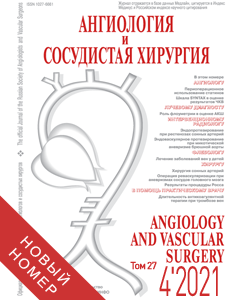Journal «Angiology and Vascular Surgery» •
2013 • VOLUME 19 • №3
Results of assessing the distance from the valve of the introducer inserted into either the right or left radial artery to the aortic bifurcation by means of an angiographic catheter
Mizin A.G., Pavlov P.I., Kiprov R.Yu.
Department of Roentgenosurgical Methods of Diagnosis and Treatment Regional Clinical Hospital, Khanty-Mansiysk, Russia
Objectives. The study was aimed at determining the length of the angiographic catheter connecting either the left or right radial access with the aortic bifurcation and at analysing the relationship between this distance and simple anthropometric parameters.
Methods and results. The study included a total of ninety-eight patients admitted to the Regional Clinical Hospital for performing elective invasive angiography of the lower extremities through a radial approach. In 47% (46/98) of cases the left radial artery was punctured and in 53% (52/98) of cases the right one. The average value of the catheter’s length from the introducer’s valve to the aortic bifurcation for the whole sample amounted to 111,5 cm (95% confidence interval 110,3–112,7 cm). We also determined several anthropometric parameters: "patient’s height", "shoulder height in the sitting position", and "span of the arms". None of the parameters measured showed statistically significant differences in the groups of patients punctioned either into the right or left radial artery (p>0,05), including the measure "catheter’s length". We revealed a significantly strong linear correlation between the measures "catheter’s length" and "patient’s height", correlation coefficient r=0,71 (p<0,0001), between the parameters "catheter’s length" and "span of the arms" r=0,71 (p<0,0001). We made an equation of regression (R-Squire 0,56): "catheter’s length" = 24 + 0.28 × "patient’s height" + 0,3 × "span of the arms".
Conclusion. The carried out analysis demonstrated no statistically significant differences in the length of the catheter connecting either the left or right radial artery with the aortic bifurcation. Also suggested herein is a model for predicting the values of the catheter’s length from the radial approach to the aortic bifurcation for patients with obliterating atherosclerosis of lower limbs, based on simple anthropometric measures "patient’s height" and "span of the arms".
KEY WORDS: abdominal aorta, anthropometry, catheter, peripheral arterial catheterization, radial artery.
P. 68
ARCHIVES MAGAZINE
2021 (Vol.27)
2020 (Vol.26)
2019 (Vol.25)
2018 (Vol.24)
2017 (Vol.23)
2016 (Vol.22)
2015 (Vol.21)
2014 (Vol.20)
2013 (Vol.19)
2012 (Vol.18)
2011 (Vol.17)
2010 (Vol.16)
2009 (Vol.15)
2008 (Vol.14)
2007 (Vol.13)
2006 (Vol.12)
2005 (Vol.11)
2004 (Vol.10)
2001 (Vol.7)
2000 (Vol.6)
1999 (Vol.5)
1998 (Vol.4)
1997 (Vol.3)


